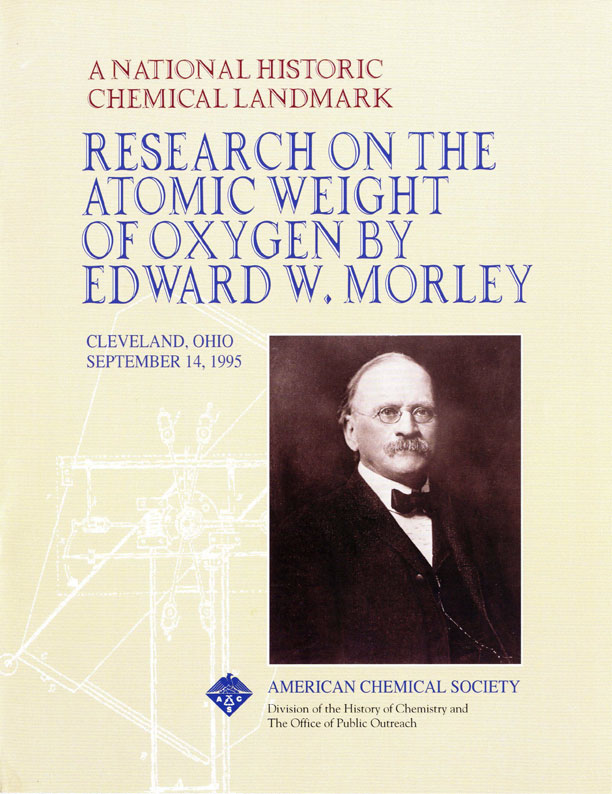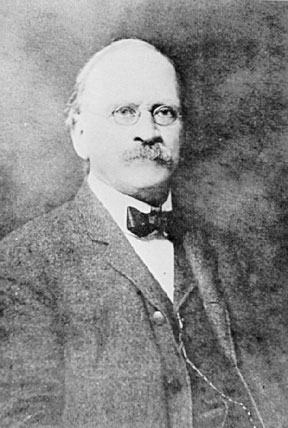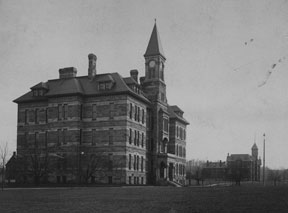Edward W. Morley and the Atomic Weight of Oxygen
Dedicated September 14, 1995, at Case Western Reserve University in Cleveland, Ohio.
In his laboratory at Western Reserve University (Now Case Western Reserve University), Edward W. Morley carried out his research on the atomic weight of oxygen that provided a new standard to the science of chemistry. The accuracy of his analyses has never been superseded by chemical means. His great work, published in 1895, also gave important insight into the atomic theory of matter.
Contents
- Determining Molecular Weights Using ‘Wet Chemistry’
- Edward W. Morley’s Early Life
- The Michelson-Morley Experiment
- Morley’s Legacy: The Atomic Weight of Oxygen
- Morley’s Methods for Determining Atomic Weight
- Morley Settles the Atomic Weight Debate
- Further Reading
- Landmark Designation and Acknowledgments
- Cite this Page
Determining Molecular Weights Using ‘Wet Chemistry’
Ever since its introduction by the English natural philosopher John Dalton at the beginning of the 19th century, the atomic theory has been central to chemistry. Each known element was presumed to consist of identical atoms, with the atoms of different elements distinguished by their differing weights. Since atoms were far too small to be measurable in absolute terms during the 19th century, chemists determined elemental atomic weights in relative terms. That is, all atomic weights were given as a multiple of that of the lightest element, hydrogen.
Atomic weight values were vital for determining chemical composition, understanding novel reactions, calculating reacting quantities in industrial processes — in short, for virtually all operations in pure and applied chemistry.
Today it is hard to comprehend the degree to which the determination of elemental atomic weights drove the work of generations of scientists spanning the century. Almost every important 19th century chemist became involved with atomic weight determinations. Dalton, Humphry Davy, Jacob Berzelius, Joseph Gay-Lussac, Jean-Baptiste Dumas, Justus von Liebig, and many others contributed their ideas and research findings. Interest was intense, and not only because atomic weight values were embedded within virtually all chemical calculations. Such knowledge was also fundamental to theories of the ultimate nature of matter.
Since the early 20th century, atomic weights have been determined easily and precisely, using sophisticated instruments such as the mass spectrometer. Before the invention of such physical methods, 19th century scientists used “wet chemistry” — procedures such as filtrations, solutions, and recrystallizations. These methods were more laborious and far less precise than physical methods.
The most important atomic weight determination was oxygen’s. Atomic weights for most other elements were determined by synthesis or analysis of oxides, and the accuracy of these weights depended directly on fixing oxygen’s weight. Moreover, a small error in the value of oxygen — a relatively light element — would be magnified proportionally for the heavier elements.
In 1895 Edward Williams Morley provided scientists with a priceless tool that made all subsequent atomic weight calculations accurate. In a publication of the Smithsonian Institution, he introduced a new value for the atomic weight ratio of oxygen to hydrogen, providing the most precise determination of the atomic weight of oxygen ever. To this day, Morley’s investigation is regarded as the pinnacle of “wet-chemical” atomic weight measurements.
Early Life of Edward W. Morley
In the opinion of many knowledgeable contemporaries, Edward Morley (1838-1923) was the best American chemist and arguably the most skillful experimentalist of his generation. The son of a Congregationalist minister, Morley was raised in Connecticut and Massachusetts and graduated from Williams College in 1860. It was facetiously said that he graduated first in his class and that no one was second.
Despite a strong childhood interest in the sciences, Morley’s first career was the ministry. He attended Andover Theological Seminary during the Civil War years, graduating in time to spend the last year of the war serving in the U.S. Sanitary Commission, which promoted the health of the Union army. He then took a position at the South Berkshire Institute, also in Massachusetts, where he taught eleven different subjects.
Morley had developed into a polymath of the highest order. A gifted linguist and musician, he mastered mathematics and all the principal sciences sufficiently to teach them at the college level. His M.D. and Ph.D. were honorary degrees (from Cleveland Medical Colleges and Wooster College, respectively), but they reflected accurately the breadth and depth of his studies. He was also, from childhood, an ingenious and meticulous craftsman, developing skills which later he put to continual use as an experimental scientist.
In 1868 Morley was invited to lead a Congregationalist church in Twinsburg, Ohio, in the northeastern part of the state known as the Western Reserve of Connecticut. But he could not resist his second and truer calling. Shortly after his arrival, he accepted a position as Instructor of Chemistry, Geology, Natural History, and Mathematics at Western Reserve College in nearby Hudson. In 1882 the school moved thirty miles north to Cleveland, from which time it was known as Adelbert College of Western Reserve University. (After merging with the Case Institute of Technology in 1967, the institution assumed its present name of Case Western Reserve University.) Morley remained there until he retired as emeritus professor in 1906, when he moved back to Connecticut with his wife, Isabella Birdsall Morley. The couple had no children.
By the last decades of the 19th century, Cleveland had become a center of industry and manufacturing. Despite the city’s growing prosperity and sophistication, however, it could boast no successful general college or university until the Case School of Applied Science began operations in 1880 with one professor and sixteen students. Within a half-dozen years, world-class scientific research was being conducted at Case and neighboring Western Reserve campuses on the eastern edge of the city, even in the face of inadequate material support.
The Michelson-Morley Experiment
Edward Morley is best known for his work with Albert Michelson (1852-1931), a professor at Case. The two men collaborated from 1885 to 1889 to produce three major projects: a repetition of the experiments of Hippolyte Fizeau (1819-1896) on the velocity of light through a moving medium; an investigation on the use of the wavelength of sodium vapor light as an absolute standard of length; and the classic ether drift experiment of 1887.
The last of these is often regarded as the most significant single experiment in the history of physics. Michelson and Morley attempted to detect the earth’s motion through the “ethereal medium,” a hypothetical substance that was thought to pervade all space. They did this by measuring the velocity of flight in different directions with hitherto unimaginable precision. Their famous null result was later used to justify Albert Einstein’s theory of relativity. For his studies on the velocity of light, Michelson won the Nobel Prize in Physics in 1907, the first American to win a Nobel prize in science.
Morley’s Legacy: The Atomic Weight of Oxygen
But Morley never regarded the Michelson collaboration as his lifework. By the time Michelson arrived at Case, Morley already was known nationally for his studies on gas analysis, and he continued to work toward measurements of various natural constants — chemical compositions, densities, weights, and lengths — with ever greater precision. He developed increasingly more elaborate apparatus and methods to eliminate impurities such as water vapor, mercury vapor, and carbon dioxide from gas samples and to weigh them more precisely. These methods were deployed in masterly fashion during his extended investigation into the atomic weight of oxygen.
In 1895 Morley calculated his value for the relative atomic weight of oxygen (on the scale hydrogen = 1 exactly) as 15.879. He published the value in his magnum opus, “On the Densities of Hydrogen and Oxygen and on the Ratio of Their Atomic Weights,” which appeared in Smithsonian Institution Contributions to Knowledge, no. 980. Briefer versions were published in the American Chemical Journal, the Zeitschrift fÜr physikalishe Chemie, and the Proceedings of the American Association for the Advancement of Science.
These publications revealed to the scientific community an elegant and highly significant body of work. Morley’s peers hailed his achievement by bestowing upon him the most prestigious awards in the profession. He was named to the National Academy of Sciences and the American Academy of Arts and Sciences, and elected to the presidencies of the American Association for the Advancement of Science (1896) and the American Chemical Society (1899-1900). Morley was also made an honorary member of several international societies, including the Royal Institution, the Chemical Society of London, and the British Association for the Advancement of Science. In 1907 he received another mark of distinction — the Davy Medal of the Royal Society.
In all, Morley published fifty-five scientific papers. The Harvard chemist O. Wolcott Gibbs wrote to Morley about his atomic weight measurements: “…your work is by far the finest piece of exact chemical investigation with which I am acquainted… There is no man living who can handle such questions as you can…” Frank Wigglesworth Clarke, chief chemist of the U.S. Geological Survey, attested: “It is hard to express an opinion concerning this investigation, without seeming to be extravagant. In thoroughness, foresight, and manipulative skill, it stands in the very front rank of chemical investigations… The paper may at once take its place among the ‘classics of the exact sciences’.”
Morley’s Methods for Determining Atomic Weight
Edward Morley went beyond all of his contemporaries in employing a complete analysis and synthesis in all of his chemical determinations. Most notably, he determined the relative atomic weight of oxygen to be 15.879 by three distinct methods, which allowed him to cross-check his results.
Many late 19th century chemists sought to determine the atomic weight of oxygen. Like most of them, Morley focused on the reaction through which water is synthesized from hydrogen and oxygen, the two elements whose atomic weights he was comparing.
Because of the extreme technical difficulties of the required procedures, all other experimenters weighed only two of the three quantities involved in this reaction. Edward Keiser, professor of chemistry at Bryn Mawr College, based his determinations on the weight of hydrogen consumed and the water generated, whereas the distinguished physicist, Lord Rayleigh, weighed only the two gases and ignored the weight of the water. The two researchers obtained the weight of the third quantity by simple subtraction. They justified this procedure by assuming the conservation of matter, and, more importantly in this case, the absolute purity of all reactants and products.
Morley avoided such assumptions. Though his technical innovations allowed him to obtain oxygen and hydrogen in purer states than had previously been possible, he correctly believed it necessary to weigh all three quantities in order to achieve the highest accuracy. His thoroughness provided two direct comparisons from which the atomic weight of oxygen could be calculated: hydrogen and water, and hydrogen and oxygen. And while Morley could not calculate atomic weights directly from the ratio of his measurement of oxygen and water—neither referred directly to hydrogen, his standard—he could, and did, use these numbers to check his other measurements.
In addition, Morley never limited himself to chemical methods; he introduced physical techniques that allowed him to evaluate his chemical determinations as none of his colleagues could. For example, he measured precisely the volumes and densities of pure hydrogen and oxygen, and, from these data, obtained an independent calculation of their relative atomic weights. The results of this method differed only in the fourth decimal place from those Morley obtained using his chemical methods. This remarkable consistence testifies to Morley’s experimental skill and to the strength of his belief in the importance of natural constants.
Morley’s study may instructively be compared with the early work of T.W. Richards, whose first (and highly celebrated) atomic weight determination, published in 1887 with his teacher, J.P. Cooke, when Richards was still a student, was that of oxygen. In contrast to Morley a few years later, Richards directly weighed only the hydrogen and water, not the oxygen. Moreover, Morley performed several times more experiments than Richards did, and commonly produced for weighing about ten times the quantities of hydrogen and water. Through such meticulousness Morley was able to achieve results with much lower probably error, on the order of one part in 10,000. It is tribute to the skills of both scientists that their results are comparable and extraordinarily close to the accepted modern value of 15.8729. This number (not technically the modern atomic weight of oxygen, but rather the modern value for the oxygen-hydrogen atomic weight ratio) is determined today by physical and instrumental rather than chemical means.
Morley Settles the Atomic Weight Debate
Morley’s work on the atomic weight of oxygen had much greater significance than simply a more precise determination of a constant of nature; it was of fundamental importance to the science of chemistry. When Morley determined the atomic weight of oxygen, he also settled a controversy that had gone on throughout his century. Many early atomic weight tables expressed all values as (whole number) integers: carbon = 12, nitrogen = 14, iron = 56, and so on. Were all atomic weights really integral multiples of the lightest element, hydrogen? If so, it would be reasonable to suppose that all elements are composed of hydrogen, more or less condensed to form atoms of the heavier elements — a suggestion first made by the English chemist William Prout in 1815.
Some of Morley’s contemporaries and immediate predecessors suggested that most elements have atomic weights that are close to, but by no means precisely, integral values. The issue was still a lively one at the end of the century. Morley’s 1895 study definitively disproved the hypothesis of integral atomic weight values. He was well aware of his consequence and discussed the subject in an address given as retiring president of the AAAS.
Morley’s “wet chemical” methods were little different in principle from chemistry of the 18th century. Such procedures are subject to many sources of error that are exceedingly difficult to eliminate. The accuracy achieved by Morley is directly attributable to his many scientific and human virtues: skill at manipulation; wide understanding of physics and chemistry; methodological inventiveness; painstaking attention to detail; intellectual honesty; and extraordinary patience. Morley’s great work marks the grand culmination of an important age in the history of chemistry. It was a milestone in our understanding of the nature of matter.
Landmark Designation and Acknowledgments
Landmark Designation
The American Chemical Society designated Edward W. Morley’s research on the atomic weight of oxygen as a National Historic Chemical Landmark in a ceremony at Case Western Reserve University’s Adelbert Hall on September 14, 1995. The plaque commemorating the event reads:
In his laboratory in the basement of this building, Edward W. Morley, Hurlburt Professor of Natural History and Chemistry from 1868 to 1906, carried out his research on the atomic weight of oxygen that provided a new standard to the science of chemistry. The accuracy of his analyses has never been superseded by chemical means. His great work, published in 1895, also gave important insight into the atomic theory of matter.
Acknowledgments
Adapted for the internet from “Research on the Atomic Weight of Oxygen by Edward W. Morley,” produced by the National Historic Chemical Landmarks program of the American Chemical Society in 1995.
Back to National Historic Chemical Landmarks Main Page
Learn more: About the Landmarks Program
Take action: Nominate a Landmark and Contact the NHCL Coordinator




